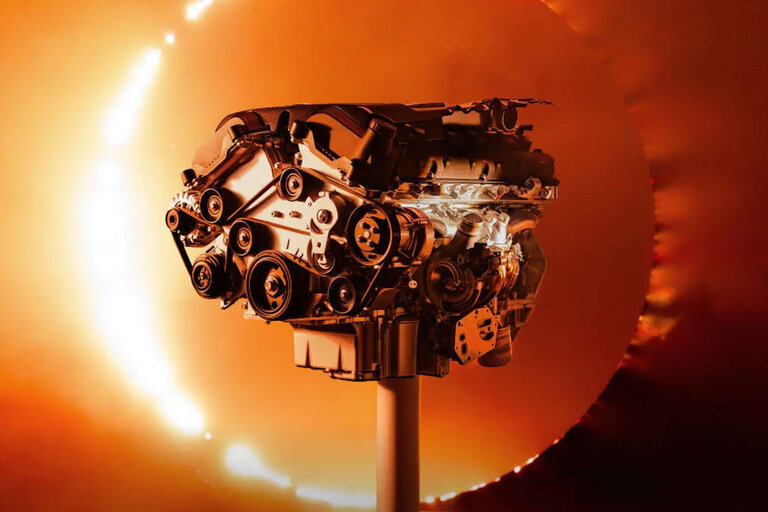
Inspired by the Taycan’s Platform
When Audi chief designer Marc Lichte saw the Porsche Taycan at an internal design presentation in Spain—an important ritual within the Volkswagen Group that used to be attended by luminaries such as Ferdinand and Ursula Piëch—he immediately recognized the potential of the car’s J1 platform. He asked whether Porsche was okay with him working on his own verison. Then he got to work, with strong emphasis on aerodynamics. What emerged is a very distinct car, an incredibly low and sporty Audi that looks very different from the Porsche Taycan. The only common parts are the windscreen and, inside, part of the B-pillar.
Design Process
The e-tron GT design process differed significantly from the usual process: From the outset, Audi used a proposal by exterior designer Parys Cybulski (pictured here), and no competing proposals were commissioned. The interior was designed by Markus Däsch.
Shaping the e-tron GT
Audi went into uncharted terrain with the complex shapes of the all-aluminum body. It took months to get the rear fender right; aluminum is far more difficult to shape than steel.
Dinamica and Wool
Audi is going “sustainable” with the interior of the e-tron GT. In addition to leather, there is a microfiber option for which Audi ditched Alcantara. The Dinamica material now used is more environmentally friendly, the company insists. And there is a third option: a wool-style fabric that uses recycled materials.
Carbon-Ceramic Brakes
Customers can configure their e-tron GT in multiple ways. For instance, there are three braking systems, including a carbon-ceramic top-of-the-line version; there is optional rear-wheel steering, and wheel sizes range from 19 to 21 inches.
Mirror Placement
Unlike on the Audi e-tron, there is no electronic mirror option because the vehicle platform was not designed for it. But the mirrors, placed on the shoulder, look sporty and harmonious just the way they are. Audi says that the electronic mirror will return on other cars.
From the Back
As various carmakers have copied the horizontal rear light strip that stretches across the width of the vehicle, Audi has broken it up on both sides with vertical dots. The design is unique and makes the car impossible to confuse with anything else, even at night.
Interior Carbon Fiber and Wood
Suppliers had their work cut out with the horizontal wood or carbon fiber strip that stretches across the dashboard. The complex shape and Audi’s slim tolerances make this decor element an extremely challenging part. The carbon fiber is matte and three-dimensional, in a departure from the usual flat, high-gloss look.
The Pre-Production e-tron GT
The design concept that Audi had journalists drive in December 2018 in Los Angeles was already made with pre-production parts and sported the final shape—with two exceptions: the (fake) air vent on the front hood, which disappeared, and the hidden door handles, which Audi replaced with regular ones.
How the RS Is Different
The e-tron GT and RS e-tron GT feature only minimal visual differentiation, and virtually all RS-specific visual elements can be fitted to the base model as well. Never before have an RS model and a regular model been so close, but Audi decided it is justifiable because the model line in its entirety serves as a technological showcase for the brand; they did not want to artificially downgrade the base model.
Taycan and e-tron GT Compared
Based on the same platform, the e-tron GT and RS e-tron GT invite comparisons with the Taycan 4S and Taycan Turbo, their counterparts from Porsche. The Audi models are governed at a slightly lower terminal velocity, and their range is slightly higher than on the Taycan models. There is no equivalent for the entry-level, rear-wheel drive only Taycan or the Taycan Turbo S, which offers a bit of extra power when the launch control function is used.
36 Steps
The e-tron GT is built alongside the R8 in Böllinger Höfe, Germany. Production takes place in 36 steps, compared with the 16 necessary for Audi’s mid-engine supercar.
Road Testing
Every single finished car is driven for 25 miles on public roads in order to check for issues. The foil shown here, which Audi used for the prototype drives on Rhodes last fall, will likely be offered as an option on the production car, not at launch, but down the road.
This content is created and maintained by a third party, and imported onto this page to help users provide their email addresses. You may be able to find more information about this and similar content at piano.io
Source link





